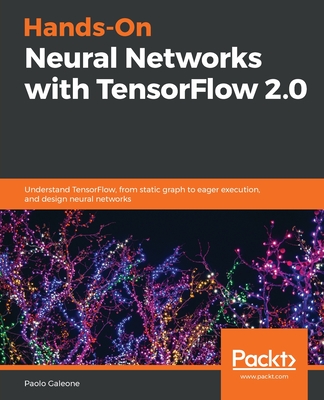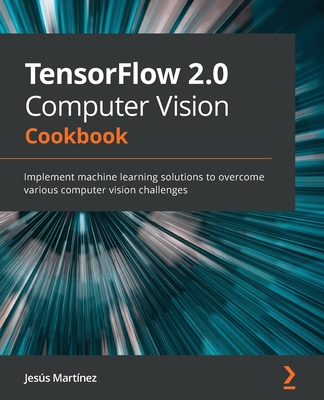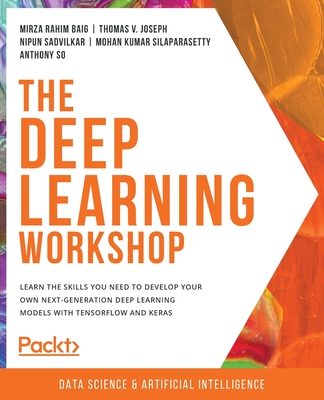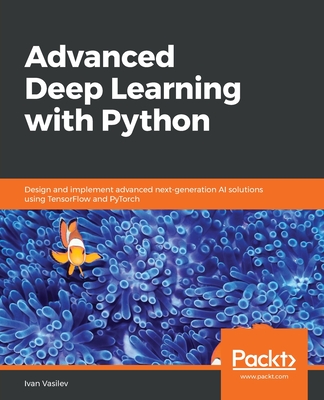Hands-On Neural Networks with TensorFlow 2.0
暫譯: 實作 TensorFlow 2.0 的神經網絡
Paolo Galeone
- 出版商: Packt Publishing
- 出版日期: 2019-09-13
- 售價: $1,820
- 貴賓價: 9.5 折 $1,729
- 語言: 英文
- 頁數: 358
- 裝訂: Quality Paper - also called trade paper
- ISBN: 1789615550
- ISBN-13: 9781789615555
-
相關分類:
DeepLearning、TensorFlow
海外代購書籍(需單獨結帳)
買這商品的人也買了...
-
 Design Patterns: Elements of Reusable Object-Oriented Software (Hardcover)
Design Patterns: Elements of Reusable Object-Oriented Software (Hardcover)$2,500$2,375 -
 $403深度學習 : 21天實戰 Caffe
$403深度學習 : 21天實戰 Caffe -
 為你自己學 Git
為你自己學 Git$500$390 -
 Hands-On Computer Vision with Tensorflow 2
Hands-On Computer Vision with Tensorflow 2$1,395$1,325 -
 $602計算統計,2/e (Computational Statistics, 2/e)
$602計算統計,2/e (Computational Statistics, 2/e) -
 SLAM 視覺十四講:雙倍內容強化版
SLAM 視覺十四講:雙倍內容強化版$690$545 -
 $250機器學習線性代數基礎 (Python 語言描述)
$250機器學習線性代數基礎 (Python 語言描述) -
 機器學習工程師面試全破解:嚴選124道AI演算法決勝題完整剖析
機器學習工程師面試全破解:嚴選124道AI演算法決勝題完整剖析$650$507 -
 $1,464Deep Learning with TensorFlow 2 and Keras, 2/e (Paperback)
$1,464Deep Learning with TensorFlow 2 and Keras, 2/e (Paperback) -
 AIOT 與 OpenCV 實戰應用:Python、樹莓派、物聯網與機器視覺
AIOT 與 OpenCV 實戰應用:Python、樹莓派、物聯網與機器視覺$480$379 -
 Python GUI 程式設計:PyQt5 實戰 (暢銷回饋版)
Python GUI 程式設計:PyQt5 實戰 (暢銷回饋版)$550$429 -
 $454聯邦學習
$454聯邦學習 -
 Towards Tensorflow 2.0:無痛打造AI模型(iT邦幫忙鐵人賽系列書)
Towards Tensorflow 2.0:無痛打造AI模型(iT邦幫忙鐵人賽系列書)$500$390 -
 $662機器視覺之 TensorFlow 2 入門原理與應用實戰
$662機器視覺之 TensorFlow 2 入門原理與應用實戰 -
 Jupyter Notebook 數據分析入門與實戰
Jupyter Notebook 數據分析入門與實戰$594$564 -
 用 TensorFlow 玩轉大數據與量化交易, 2/e
用 TensorFlow 玩轉大數據與量化交易, 2/e$650$553 -
 白話演算法!培養程式設計的邏輯思考 (Grokking Algorithms: An illustrated guide for programmers and other curious people)
白話演算法!培養程式設計的邏輯思考 (Grokking Algorithms: An illustrated guide for programmers and other curious people)$520$468 -
 台積電為何這麼強:半導體的計算光刻及佈局優化
台積電為何這麼強:半導體的計算光刻及佈局優化$720$569 -
 7天學會大數據資料處理 — NoSQL:MongoDB 入門與活用, 4/e
7天學會大數據資料處理 — NoSQL:MongoDB 入門與活用, 4/e$600$468 -
 跟著 Docker 隊長,修練 22天就精通 - 搭配 20小時作者線上教學,無縫接軌 Microservices、Cloud-native、Serverless、DevOps 開發架構
跟著 Docker 隊長,修練 22天就精通 - 搭配 20小時作者線上教學,無縫接軌 Microservices、Cloud-native、Serverless、DevOps 開發架構$880$695 -
 凡人也能懂的白話人工智慧演算法 (Grokking Artificial Intelligence Algorithms)
凡人也能懂的白話人工智慧演算法 (Grokking Artificial Intelligence Algorithms)$580$458 -
 親手開發推薦系統 - PyTorch 全方位實作最重要演算法
親手開發推薦系統 - PyTorch 全方位實作最重要演算法$780$616 -
 Deep Learning 4|用 Python 進行強化學習的開發實作
Deep Learning 4|用 Python 進行強化學習的開發實作$680$537 -
 多模態大模型:技術原理與實戰
多模態大模型:技術原理與實戰$600$570 -
 $412Llama 大模型實踐指南
$412Llama 大模型實踐指南
商品描述
Key Features
- Understand the basics of machine learning and discover the power of neural networks and deep learning
- Explore the structure of the TensorFlow framework and understand how to transition to TF 2.0
- Solve any deep learning problem by developing neural network-based solutions using TF 2.0
Book Description
TensorFlow, the most popular and widely used machine learning framework, has made it possible for almost anyone to develop machine learning solutions with ease. With TensorFlow (TF) 2.0, you'll explore a revamped framework structure, offering a wide variety of new features aimed at improving productivity and ease of use for developers.
This book covers machine learning with a focus on developing neural network-based solutions. You'll start by getting familiar with the concepts and techniques required to build solutions to deep learning problems. As you advance, you'll learn how to create classifiers, build object detection and semantic segmentation networks, train generative models, and speed up the development process using TF 2.0 tools such as TensorFlow Datasets and TensorFlow Hub.
By the end of this TensorFlow book, you'll be ready to solve any machine learning problem by developing solutions using TF 2.0 and putting them into production.
What you will learn
- Grasp machine learning and neural network techniques to solve challenging tasks
- Apply the new features of TF 2.0 to speed up development
- Use TensorFlow Datasets (tfds) and the tf.data API to build high-efficiency data input pipelines
- Perform transfer learning and fine-tuning with TensorFlow Hub
- Define and train networks to solve object detection and semantic segmentation problems
- Train Generative Adversarial Networks (GANs) to generate images and data distributions
- Use the SavedModel file format to put a model, or a generic computational graph, into production
Who this book is for
If you're a developer who wants to get started with machine learning and TensorFlow, or a data scientist interested in developing neural network solutions in TF 2.0, this book is for you. Experienced machine learning engineers who want to master the new features of the TensorFlow framework will also find this book useful.
Basic knowledge of calculus and a strong understanding of Python programming will help you grasp the topics covered in this book.
商品描述(中文翻譯)
#### 主要特點
- 了解機器學習的基本概念,發現神經網絡和深度學習的強大功能
- 探索 TensorFlow 框架的結構,了解如何過渡到 TF 2.0
- 通過使用 TF 2.0 開發基於神經網絡的解決方案來解決任何深度學習問題
#### 書籍描述
TensorFlow 是最受歡迎且廣泛使用的機器學習框架,使幾乎任何人都能輕鬆開發機器學習解決方案。使用 TensorFlow (TF) 2.0,您將探索重新設計的框架結構,提供各種新功能,旨在提高開發者的生產力和易用性。
本書涵蓋機器學習,重點在於開發基於神經網絡的解決方案。您將首先熟悉構建深度學習問題解決方案所需的概念和技術。隨著進展,您將學習如何創建分類器、構建物體檢測和語義分割網絡、訓練生成模型,並使用 TF 2.0 工具(如 TensorFlow Datasets 和 TensorFlow Hub)加速開發過程。
在本書結束時,您將能夠通過使用 TF 2.0 開發解決方案並將其投入生產,來解決任何機器學習問題。
#### 您將學到什麼
- 掌握機器學習和神經網絡技術以解決具有挑戰性的任務
- 應用 TF 2.0 的新功能以加速開發
- 使用 TensorFlow Datasets (tfds) 和 tf.data API 構建高效的數據輸入管道
- 使用 TensorFlow Hub 進行遷移學習和微調
- 定義和訓練網絡以解決物體檢測和語義分割問題
- 訓練生成對抗網絡 (GANs) 以生成圖像和數據分佈
- 使用 SavedModel 文件格式將模型或通用計算圖投入生產
#### 本書適合誰
如果您是希望開始學習機器學習和 TensorFlow 的開發者,或是對在 TF 2.0 中開發神經網絡解決方案感興趣的數據科學家,本書適合您。希望掌握 TensorFlow 框架新功能的經驗豐富的機器學習工程師也會發現本書有用。
具備基本的微積分知識和扎實的 Python 編程理解將有助於您掌握本書所涵蓋的主題。
作者簡介
Paolo Galeone is a computer engineer with strong practical experience. After getting his MSc degree, he joined the Computer Vision Laboratory at the University of Bologna, Italy, as a research fellow, where he improved his computer vision and machine learning knowledge working on a broad range of research topics. Currently, he leads the Computer Vision and Machine Learning laboratory at ZURU Tech, Italy.
In 2019, Google recognized his expertise by awarding him the title of Google Developer Expert (GDE) in Machine Learning. As a GDE, he shares his passion for machine learning and the TensorFlow framework by blogging, speaking at conferences, contributing to open-source projects, and answering questions on Stack Overflow.
作者簡介(中文翻譯)
**Paolo Galeone** 是一位具有豐富實務經驗的計算機工程師。在獲得碩士學位後,他加入了意大利博洛尼亞大學的計算機視覺實驗室,擔任研究員,在這裡他在多個研究主題上提升了自己的計算機視覺和機器學習知識。目前,他在意大利的 ZURU Tech 領導計算機視覺與機器學習實驗室。
在 2019 年,Google 以機器學習領域的專業知識授予他 Google Developer Expert (GDE) 的稱號。作為 GDE,他透過寫部落格、在會議上演講、貢獻開源專案以及在 Stack Overflow 上回答問題,分享他對機器學習和 TensorFlow 框架的熱情。
目錄大綱
- What is Machine Learning?
- Neural Networks and Deep Learning
- TensorFlow Graph Architecture
- TensorFlow 2.0 Architecture
- Efficient Data Input Pipelines and Estimator API
- Image Classification using TensorFlow Hub
- Introduction to Object Detection
- Semantic Segmentation and Custom Dataset Builder
- Generative Adversarial Networks
- Bringing a Model to Production
目錄大綱(中文翻譯)
- What is Machine Learning?
- Neural Networks and Deep Learning
- TensorFlow Graph Architecture
- TensorFlow 2.0 Architecture
- Efficient Data Input Pipelines and Estimator API
- Image Classification using TensorFlow Hub
- Introduction to Object Detection
- Semantic Segmentation and Custom Dataset Builder
- Generative Adversarial Networks
- Bringing a Model to Production





























